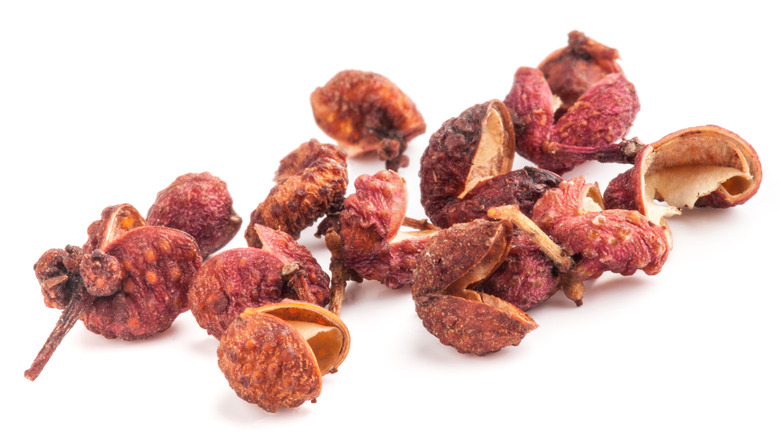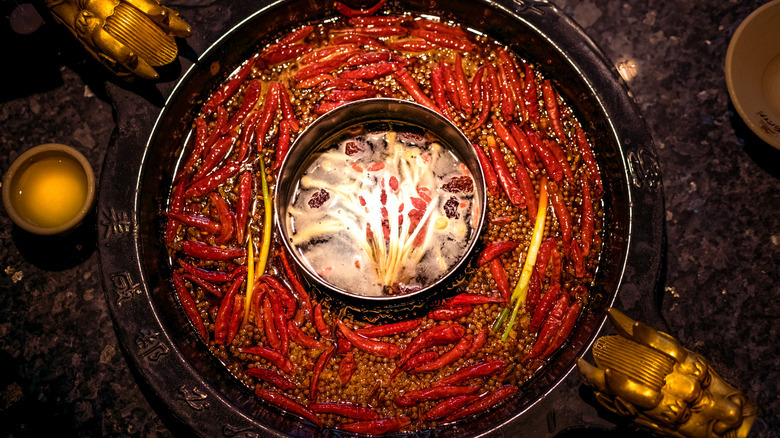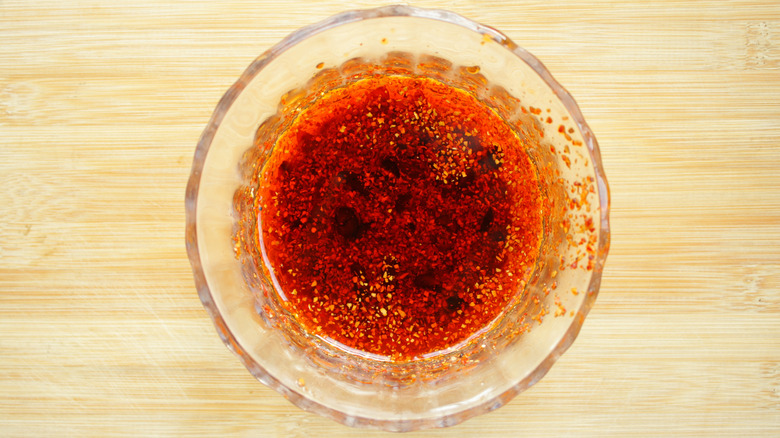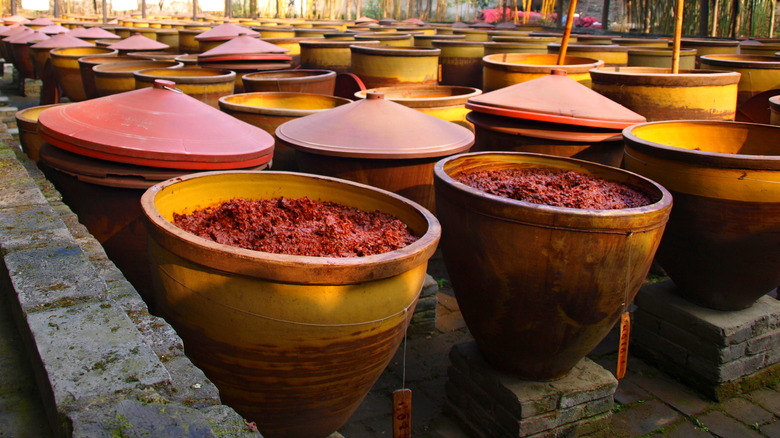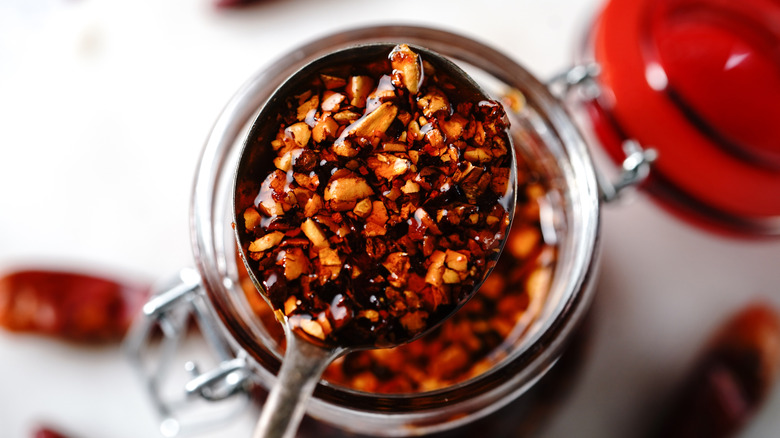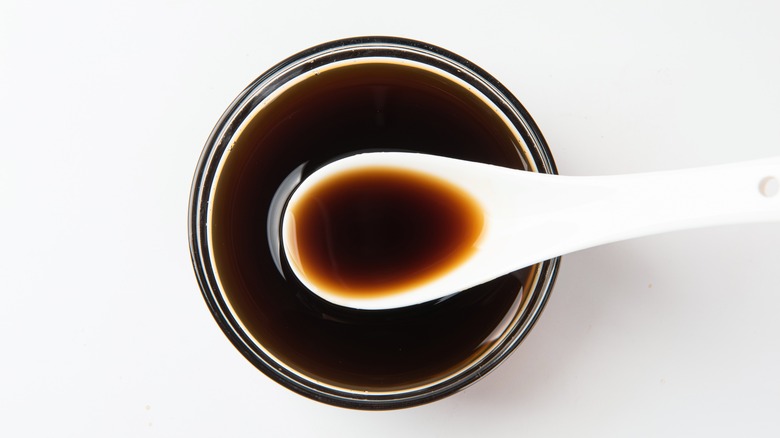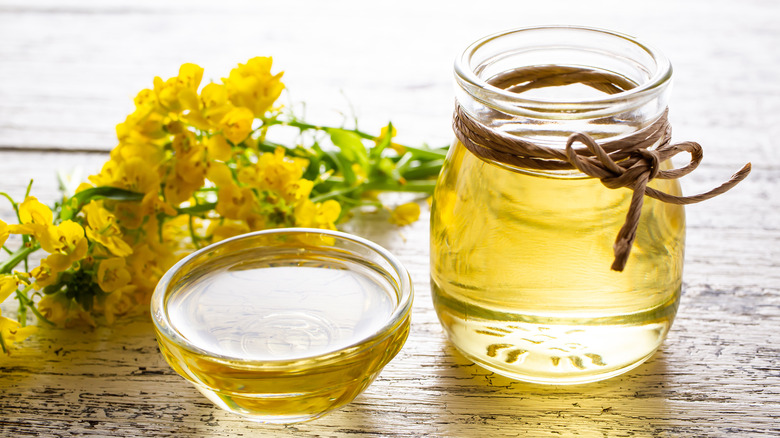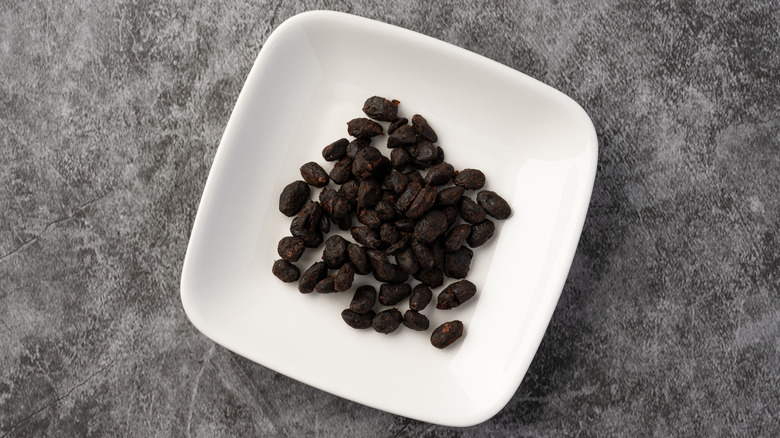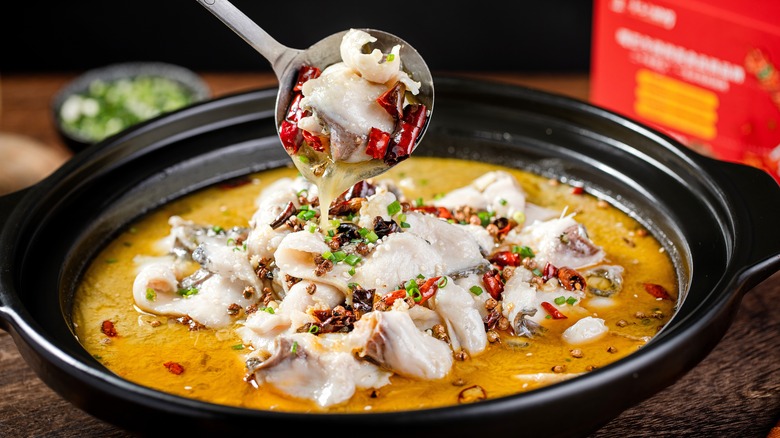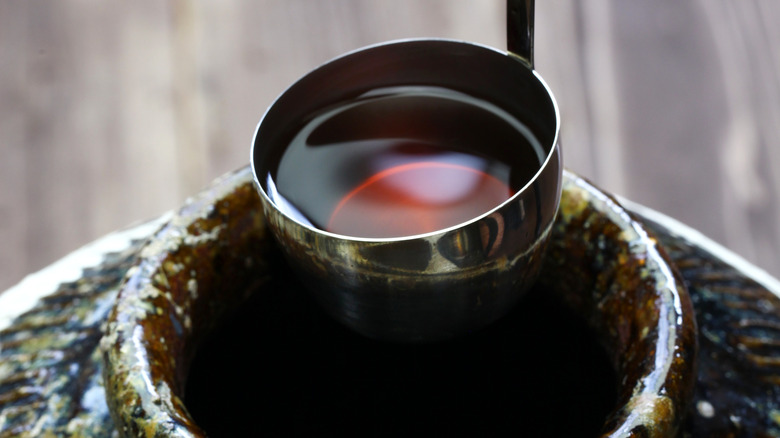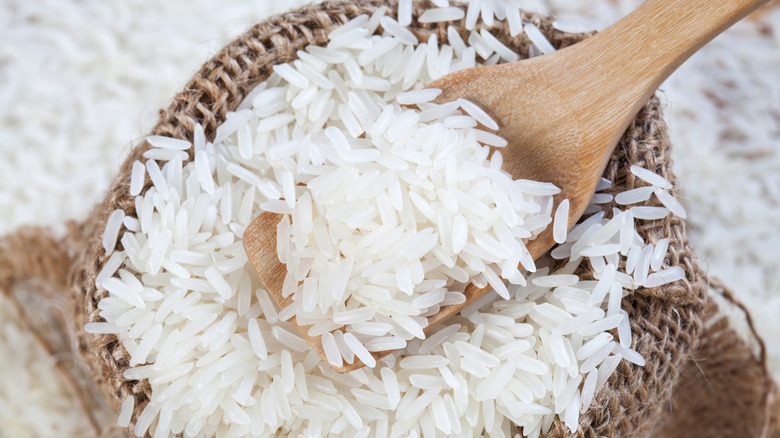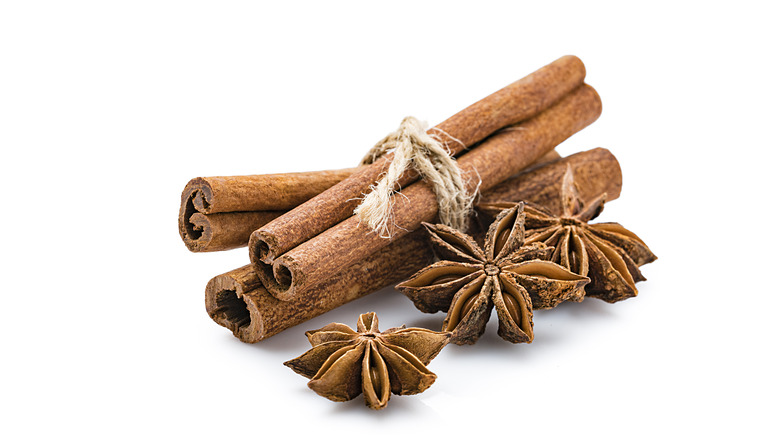13 Pantry Essentials For Sichuan Cooking, According To Fly By Jing Founder Jing Gao
We may receive a commission on purchases made from links.
Fly By Jing is a food company started by Chengdu, Sichuan native Jing Gao. It produces a line of food products inspired by (and made using ingredients from) Sichuan, China, a region known for its intense flavors and vibrant culinary culture. In addition to pre-made sauces and seasonings like chili crisp, zhong sauce, and ma la spice mix, the company also sells some basic pantry essentials for cooking Sichuan food.
Jing Gao also has a new cookbook, "The Book of Sichuan Chili Crisp," that's full of recipes both traditional and nontraditional that incorporate the flavors of Sichuan. Given her expertise, she is the perfect person to ask for advice on how to stock your kitchen for Sichuan cooking. In an exclusive interview with Tasting Table, Jing listed some crucial components you'll need to make Sichuan dishes at home and explained what makes these ingredients so special. It may require a trip to the Asian grocery store or some online shopping, but most of these ingredients are readily available in the U.S. With just a few extra things in your pantry, you'll be able to whip up hot pot, mapo tofu, kung pao chicken, and more in no time.
1. Sichuan pepper
Sichuan pepper is one of the most confusing ingredients in the Sichuan pantry, partially because of its misleading English name. As Jing Gao explained, Sichuan pepper is neither a chili pepper nor a relative of black pepper, and it's not spicy. "It's actually the seed of a citrus tree, and that's why it has a citrusy, floral flavor." But even more than its flavor, Sichuan pepper is known for the sensation it gives you when it hits your tongue — a mix of numbing and tingly that you won't get from any other ingredient.
The highest quality Sichuan pepper has to be hand-harvested because the oils that are responsible for its flavor are quite delicate and can be damaged by machines. The taste also degrades over time, so it's best to eat Sichuan pepper relatively soon after harvesting — Jing said it can be stored in the freezer to extend its shelf life.
The seeds are typically roasted to bring out their flavor and used in one of two basic ways. In long-cooking dishes like braises and stews, they can be added whole towards the beginning of the cooking process. In other applications where you don't want to crunch on whole peppercorns, they can be ground into a powder and applied as a finishing spice.
2. Erjingtiao chilis
When the heat of chili peppers is combined with the tingling sensation of Sichuan peppercorns, it creates one of the most important flavors in Sichuan food: ma la, or spicy-numbing. Dried chilis are commonly used for most dishes in Sichuan; the region produces and eats a variety of different peppers, but the most popular is erjingtiao, according to Jing Gao. "It's known for how fragrant it is — it smells incredible. The taste is fruity and warm. And it's not too spicy," she said.
Depending on your spice tolerance, you may find erjingtiaos to be pretty hot, but since they're less spicy than some other types of Chinese chilis, they can be used in higher quantities in food, which allows aficionados to appreciate their intoxicating flavor. This chili variety also has a bold red color that makes dishes pop visually. This is why Jing recommends the erjingtiao if you're only going to buy one type of chili for your Sichuan recipes.
Jing had some suggestions for serious spice-heads who want to experiment with more heat than the erjingtiao can provide. She said dried Thai birdseye chilis would work well in Sichuan dishes; they're similar to a Chinese chili that is difficult to source in the U.S. If you really want to crank up the intensity, Indian ghost peppers will do the trick — they'll bring loads of heat, but they won't change the flavor profile of recipes very much.
3. Chili oil
If you want the heat and flavor of chilis in your food but don't want to pick through chunky pieces of peppers, then chili oil is the way to go. To make it, Jing Gao likes to use about a 4-to-1 ratio of oil to dried chilis. The oil is heated up and poured over the chilis, and then the mixture is allowed to sit to give the oil time to extract the flavor. Then, after straining, the chili oil should be red, spicy, and ready to use in your favorite recipes.
Sometimes, chili oil is made with just peppers and oil, but cooks often add spices like cardamom, cinnamon, or star anise to increase the fragrance and depth of flavor. As for what to use it on, the options are almost limitless. Per Jing Gao, "You can make cold appetizers like cucumber salad, you can fry with it, use it in mapo tofu, or make a noodle dish where you mix it with soy sauce and black vinegar and garlic."
The same heating and infusing method can also be applied to Sichuan peppercorns to make Sichuan pepper oil. The numbing properties of the peppercorns will be transferred to the oil, which can be drizzled on a multitude of foods.
4. Doubanjiang
In our interview, Jing Gao referred to Doubanjiang as "the star of the Sichuan pantry" and "the soul of Sichuan cuisine." It's a paste composed of fava beans and erjingtiao chilis that are fermented together in clay pots; the flavor combines spice and umami in a way that's totally unique and extremely compelling.
The longer doubanjiang is aged, the deeper and more interesting the flavor becomes. "Most industrially-made doubanjiangs are only aged for a few months," she explained. "They're still good, but you get more complexity if you ferment it for longer." The one she prefers is fermented for three years.
When incorporating doubanjiang into recipes like Sichuan-style red-braised beef or other stewed dishes or stir-fries, it's typical to cook the paste in oil by itself before adding other ingredients. The paste infuses the oil, allowing it to flavor everything else in the dish. A little goes a long way; Jing estimated that 500 grams of doubanjiang might last you a year if you don't cook Sichuan food every day.
5. Chili crisp
You might think of chili crisp as the more complicated, more robust sibling of chili oil. It's made in a similar fashion to chili oil — oil is heated up and poured over a blend of chilis and other flavorful ingredients. However, for chili crisp, the ingredients are left in the oil rather than being strained out. The chilis basically fry during the cooking process and transform into crunchy little chips. Also, chili crisp tends to use a greater variety of ingredients than chili oil, incorporating umami boosters and aromatics to make a well-rounded condiment. Fly By Jing chili crisp includes ingredients like shallots, garlic, Sichuan pepper, and mushroom powder. When you spoon chili crisp over a dish at the last minute, you enhance it in a number of ways; you're adding texture, savoriness, and a moderate amount of heat.
Jing Gao stressed to us that chili crisp is a method rather than one specific food. She considers her product to be a Sichuan chili crisp because it is made with ingredients from that area, but the same technique can be used to craft chili crisps with an infinite number of flavor profiles. "You might make one that's more Mexican, or make one that reflects the flavors of eastern China. It really is such a personal thing."
6. Black vinegar
Jing Gao listed black vinegar as an ingredient that, while not exclusively Sichuan, is necessary to stock in a basic Sichuan pantry because it's used in so many dishes from the region. Black vinegar is made in unique ways across different regions of China. It always starts with a grain base that's fermented into vinegar and then aged to give it its trademark dark color. The vinegars from different areas have their own special flavors, but they're united by a combination of umami savoriness with a hint of malty sweetness — they don't have the intense, one-note acidity of distilled vinegar.
Sichuan does produce its own variety of black vinegar fermented from a wheat bran base and infused with aromatics, but you don't necessarily need this specific type to cook Sichuan food. A typical black vinegar made with a mix of grains or just rice will work perfectly well. Black vinegar is great on noodles; it's a crucial supporting player in the Sichuan classic dan dan noodles, bringing some sourness to balance out the richness of sesame paste and the heat of chili oil.
7. Soy sauce
Like black vinegar, Jing Gao says soy sauce is "something that's not necessarily Sichuan-specific, but you can get really good Sichuan versions of it.". It's one of the main ways salt and umami are added to food in Sichuan cuisine (and Chinese cooking more broadly). You'll see it incorporated into sauces, marinades, soups, and more.
One Sichuan application that really highlights soy sauce is the cold appetizers Jing mentioned when we were talking about chili oil. The main ingredient in these plates, whether it's slices of cold cooked pork or raw cucumbers, is often dressed in a mixture of chili oil and soy sauce. Frequently, the soy sauce is a special enhanced, sweetened version cooked with sugar and seasonings like bay leaves, fennel, black cardamom, and star anise. The spices enhance the complexity of the soy sauce while the sugar helps tone down its saltiness and create a thicker texture, allowing the sauce to coat pieces of food without running off.
The traditional soy sauce for this type of dish is all-purpose soy sauce that's sort of a middle ground between light and dark soy sauce. Light soy, which is common in Cantonese cuisine, is saltier than the type you want for Sichuan-style sweetened soy sauce.
8. Rapeseed oil
Fly By Jing chili crisp is made with rapeseed oil, which Jing Gao said is the traditional cooking oil in Sichuan that has been used for thousands of years. She sang its praises, saying, "It's super healthy, it's cold-pressed ... it's got nothing to do with European rapeseed oil or canola oil, which people get confused about sometimes."
Indeed, Sichuan rapeseed oil and canola are very different ingredients. While canola plants began as a specially-bred form of rapeseed, they contain much less erucic acid than standard rapeseed, which may be toxic in extraordinarily high doses. They also have fewer glucosinolates, which have a peppery, horseradish-like flavor. Canola oil is extensively refined to be basically flavorless.
In contrast, Sichuan rapeseed oil is not neutral — it brings its own flavor to the party. The oil has a toasted nutty flavor and grassy aroma that can't be replicated by any other cooking oil. Like canola, it's made with relatively low-erucic rapeseed, but it uses a different strain.
9. Fermented black beans
Fermented black beans are another ingredient that shows up in Fly By Jing chili crisp. The beans add savory, salty depth and umami to the recipe. Despite their color, fermented black beans are not made with black beans like you'd find at a Mexican restaurant. Instead, they start out as soybeans, which are naturally a yellowish color — it's the fermentation that turns them black. This ingredient is widely used in both the Sichuan and Cantonese styles of Chinese food.
To transform soybeans into fermented black beans, they are cooked and then subjected to two stages of fermentation with Aspergillus oryzae fungus and salt. Once this is complete, the beans are typically dried before packaging.
This ingredient is an important part of what's known as the Sichuan homestyle flavor profile (common seasoning combinations in Sichuan food are broken down into different flavor profiles and given special names). The backbone of homestyle flavor is fermented black beans and soy sauce. A good example of this flavor profile is twice-cooked pork, which is made by simmering pork before stir-frying it with black beans, soy sauce, doubanjiang, and other ingredients.
10. Pickles
When we talk about pickles in the Sichuan context, we're not referring to the dill spears jarred in vinegar you'd find in a Western supermarket. Jing Gao told us, "The type of pickles they're known for there are lacto-fermented — they're fermented naturally in a salt brine with lots of different Sichuan spices and baijiu, which is the grain liquor that's very prevalent in China." There's a recipe for an all-purpose pickle brine in Jing's book, and it's also easy to find packaged versions of Chinese fermented vegetables in Asian grocery stores.
A variety of different vegetables are fermented in this way. You may find a mix of radish, cabbage, carrot, and other components fermented together to make Pao Cai. Pickled chilis are another classic fermented product; they're used in many recipes. Pickled components add acidity and umami complexity to anything they're added to — one great example is Suan Cai Yu, or fish with pickled mustard greens (pictured above). In this brothy dish, the clean (but slightly bland) flavor of white fish is elevated by a cooking liquid made with fermented mustard greens, chicken stock, chilis, and aromatics.
11. Shaoxing wine
Although Shaoxing wine isn't made in the Sichuan region (it's named after the city it's from, which is in the eastern part of China), according to Jing Gao, it's the most commonly used cooking wine in all of China, including Sichuan.
Shaoxing wine is a type of aged rice wine with an amber color. It has a complex savory and mildly sweet flavor and is one of the most basic ingredients used in Chinese cuisine, showing up in stir-fries, sauces, braises, marinades, and more. It's a critical part of one of the most famous Sichuan dishes in America, kung pao chicken. The most similar Western product to Shaoxing wine is probably dry sherry, but it's easy to find the real stuff in Asian supermarkets. The type used for cooking rather than drinking tends to be pre-seasoned with salt.
In terms of what to look for when you're buying Shoaxing wine, Jing said it's a good idea to read the label. "If you go to the grocery store and it says 'Shaoxing' and it's from that region, it'll probably be pretty good."
12. Rice
Jing Gao said, "Sichuan is not a super rice-producing region, so we'd typically get our rice from the south of the country." Southern China is where most of the country's rice is grown.
Nevertheless, rice is an important ingredient in Sichuan cuisine. What would a bowl of mapo tofu be without a side of rice to soak up all the delicious sauce? In addition to its frequent place as a side for flavorful main dishes, rice can also be the star of recipes like fried rice.
Many strains of rice are eaten in China, including short, medium, and long-grain varieties as well as sticky/glutinous types. Although Sichuan is not a rice-producing paradise these days, it did historically grow some rice, and the local preference was for long-grain. If you're looking for a long-grain rice that will complement Sichuan recipes, jasmine rice is a good choice that's easy to find in the U.S. Although it's originally Thai, it's widespread in China too, and has a fluffy texture and fragrant smell that work well with a range of Asian cuisines.
13. Aromatics (black cardamom, star anise, cassia bark)
A large number of aromatics show up in some Sichuan recipes, but Jing Gao called out these three as ones that are particularly worth having around because they're used so frequently. Black cardamom is distantly related to the (more common in the U.S.) green cardamom that you may know from Indian/South Asian recipes. In China, whole pods of black cardamom are typically added to brothy, slow-cooking recipes like stews and braises. Since it's cooked over an open fire when it's processed, black cardamom imparts a mildly smoky flavor in addition to slight pepperiness to food.
Star anise is also commonly used whole. The beautiful star-shaped pods have a licorice-like flavor (though not as strong as licorice). Anise perfumes hot pot broth, meat dishes, and chili oils, and can even be incorporated into desserts.
Finally, cassia bark, or Chinese cinnamon, tastes like, well, cinnamon. In whole cinnamon stick form, it is often added in concert with the other two aromatics we've already mentioned in braises, broths, and hot pot bases. Along with star anise, it is a component of Chinese five-spice powder.

